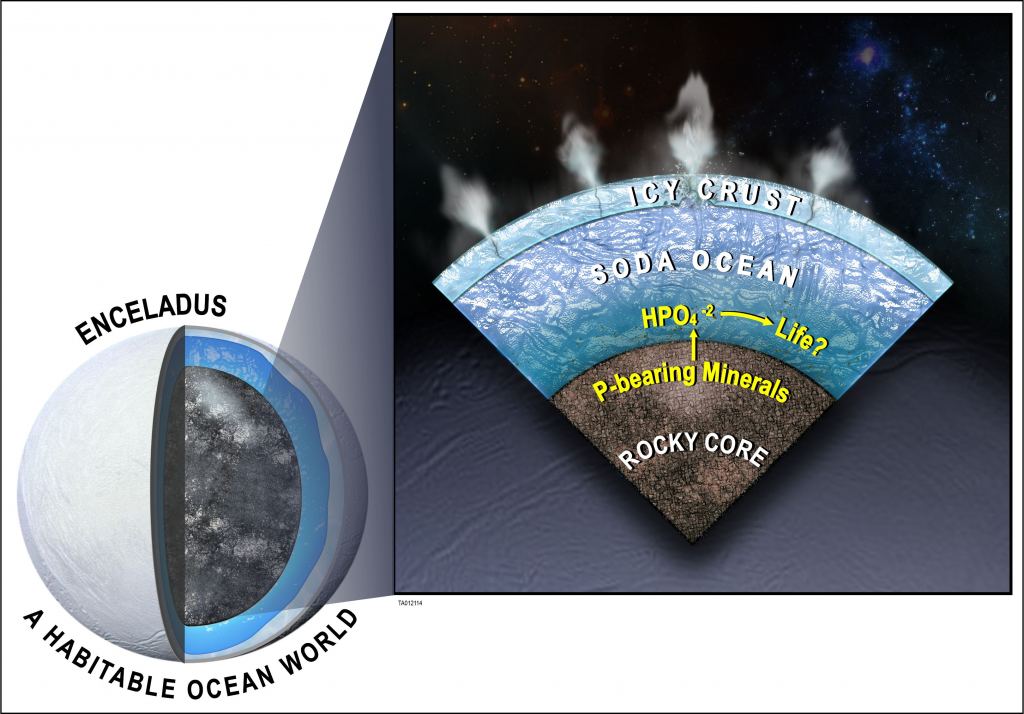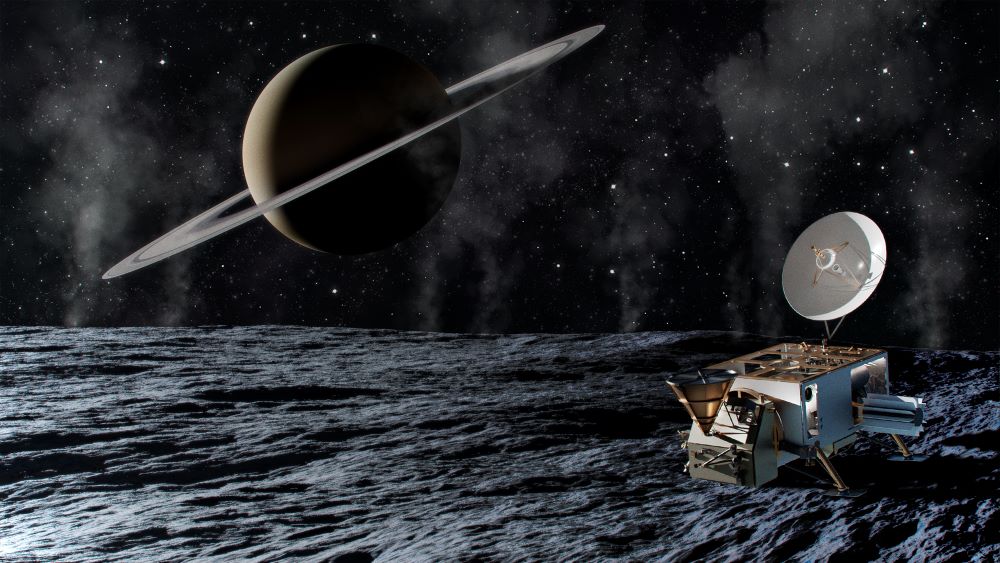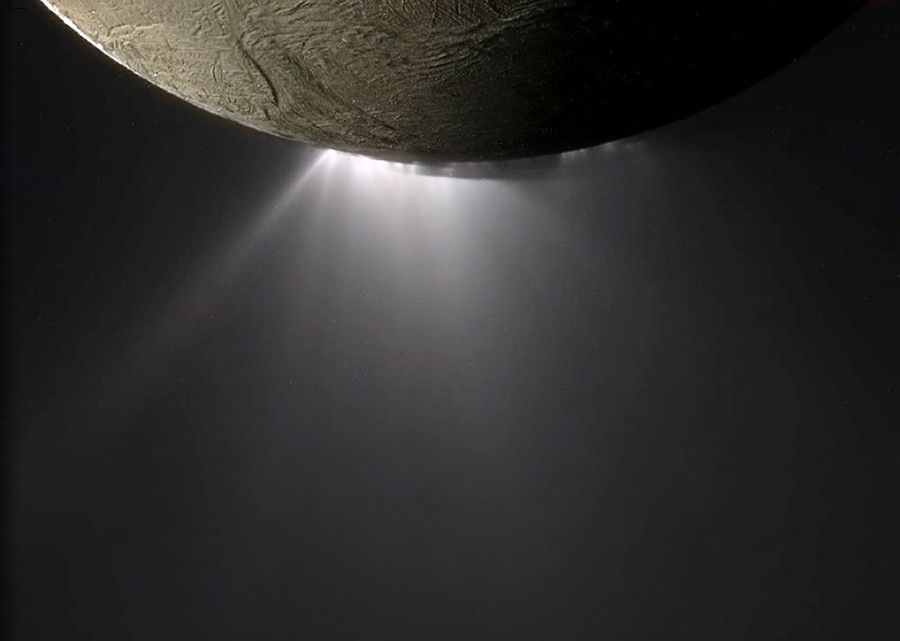We really need to get back to Enceladus. Not to send people necessarily, although that would be nice. But, we need to get some more robotic missions out there. This moon is one of the most intriguing places in the solar system. Not only has it got oceans under that icy crust, but it’s spewing salty water out to space. Plus, that water seems to be rich in phosphates, which contain phosphorus, which is a building block of life.
That’s what a team from the Southwest Research Institute led by Christopher Glein found as they analyzed data from the late Cassini mission. It spent 13 years studying the Saturn system and enabled the discovery of that moon’s subsurface oceans. “We found phosphate concentrations at least 100 times higher in the moon’s plume-forming ocean waters than in Earth’s oceans,” Glein said. “Using a model to predict the presence of phosphate is one thing, but actually finding the evidence for phosphate is incredibly exciting. This is a stunning result for astrobiology and a major step forward in the search for life beyond Earth.”
Glein noted that he and his team used geochemical modeling to predict abundant amounts of phosphorus in the Enceladean ocean. “Now, we have found abundant phosphorus in plume ice samples spraying out of the subsurface ocean,” he said.
Cassini, Phosphorus, and Life
The search for water is important in the hunt for life—and habitable conditions—on other worlds. The existence of subsurface oceans in multiple solar system locales indicates that habitable worlds can exist beyond the “Goldilocks zone” where Earth lies, according to Glein. “Geochemical experiments and modeling demonstrate that such high phosphate concentrations result from enhanced phosphate mineral solubility, in Enceladus and possibly other icy ocean worlds in the solar system beyond Jupiter,” he said. “With this finding, the ocean of Enceladus is now known to satisfy what is generally considered to be the strictest requirement for life. The next step is clear: we need to go back to Enceladus to see if the habitable ocean is actually inhabited.”

The discovery came from Cassini’s flights through plumes emanating from Enceladus. They seem to be rich in organic molecules and other materials. Followup analysis of salt-rich ice grains in the plumes showed the presence of sodium phosphates (a form of salt that combines phosphorus with sodium. Phosphorus is a huge part of life on Earth. DNA and RNA wouldn’t exist without it. The element exists in life-carrying molecules, cell membranes, bones, and teeth. It’s found across a range of life from humans to plankton and without it, life wouldn’t be here.
Expanding the “Life Zone”
That’s what makes it so amazing to find it on Enceladus. While there’s no indication that life exists there, it’s an important find in the search for habitable conditions beyond Earth. “We found phosphate concentrations at least 100 times higher in the moon’s plume-forming ocean waters than in Earth’s oceans,” Glein said. “Using a model to predict the presence of phosphate is one thing, but actually finding the evidence for phosphate is incredibly exciting. This is a stunning result for astrobiology and a major step forward in the search for life beyond Earth.”
Of course, we’re more familiar with the idea of Earth-like worlds that have surface oceans. For that surface water to exist, the planet has to be inside a pretty narrow range of temperatures relative to its star. By contrast, places with subsurface oceans could be almost anywhere. If so, then the number of habitable worlds in the galaxy could be much, much larger.
Will We Return to Enceladus?
Given this and other discoveries at Enceladus, it looks like a tempting place for a “revisit” mission. At the moment, there aren’t any missions on the way to that distant icy world. However, there’s an interesting one on the drawing boards at NASA. it’s called “Orbilander” and if it gets funded, built, and sent, it would arrive in the late 2030s.

The idea is to follow up on all the amazing science Cassini did. First, it would orbit the moon, looking for a place to land. Then, it would carry a suite of instruments to the surface for further investigations. Obviously, the plumes would be a prime place to study. Not only will their icy crystals provide more clues to the interior, but the “geological” framework for those plumes needs to be examined.
Of course, any such lander should be primed to look for life signs, past or present. The first test would be to see if those subsurface waters are habitable. That means studying the temperature, nutrient load, salinity, and other factors that influence the existence of life. Until then, however, scientists continue to study the available Cassini data in minute detail. What they find will help develop the instruments that NASA, or any other space agency, will send to Enceladus.
For More Information
Key Building Block for Life Found at Saturn’s Moon Enceladus
Detection of Phosphates Originating from Enceladus’s Ocean
Enceladus Orbilander


There are at least two reasons this is huge!
First, it makes Enceladus the prime site for astrobiology research.
Second, it turns the usual biochemistry ideas of protocell evolution on its head. The minor biochemist part of astrobiology research has maintained that organic orthophosphates shouldn’t be around in the global ocean all other data says it evolved in. The early Earth ocean was likely dominantly acidic (precisely because of the CO2 dissolved from the atmosphere). But the early crust turnover produced local alkaline hydrothermal vent systems analogous to what we see today. Closer to mantle upwelling (today in the ocean: MORBs) the hydrothermal vents are acidic while they leach out hydrogen and iron, but then the crust modifies towards less iron compounds further away along a crustal dynamic ocean floor the vents are alkaline.
On the first, Carolyn Porko notes:
“The finding makes Enceladus “the most promising place, the lowest-hanging fruit, in our solar system to search for extraterrestrial life,” Carolyn Porco, a planetary scientist who was not involved in the research, tells National Geographic’s Charles Q. Choi.” [Smithsonian Magazine]
On the second, the team notes:
“Still, the team was not sure how Enceladus had gotten such high amounts of phosphates in the first place. So, they performed some lab experiments that suggested the moon’s ocean hosts lots of dissolved carbonates, just like soda. In this way, the so-called soda ocean can dissolve phosphate-filled rocks, leading to the high concentrations of phosphates in the water, per the New York Times’ Katrina Miller. “No one would be surprised if there’s phosphate in the rock of Enceladus. There’s phosphates on comets … it is not a big deal,” Postberg tells Space.com. “The big deal is that it is dissolved in the ocean, and with that, [it’s] readily available for the potential formation of life.”” [Smithsonian Magazine]
As for additional missions, ESA has some Enceladus mission proposals they may still be looking over [“ESA is Considering a Mission to Enceladus”, Universe Today NOVEMBER 3, 2022 BY ANDY TOMASWICK] and there is a private mission in the works [“Breakthrough Enceladus mission”, Wikipedia].